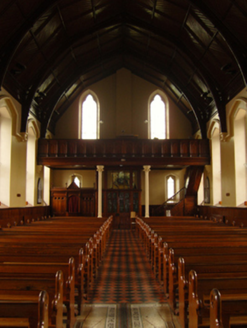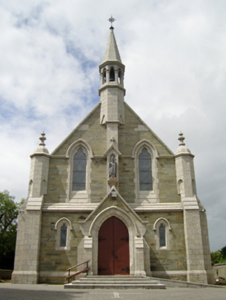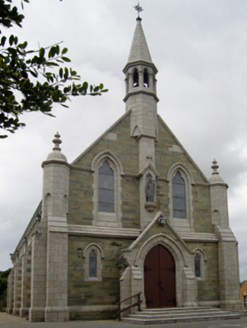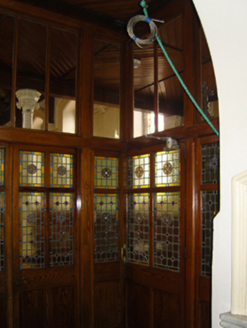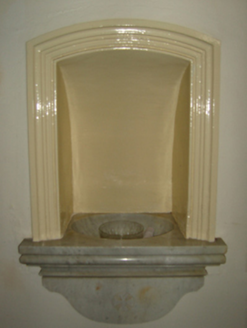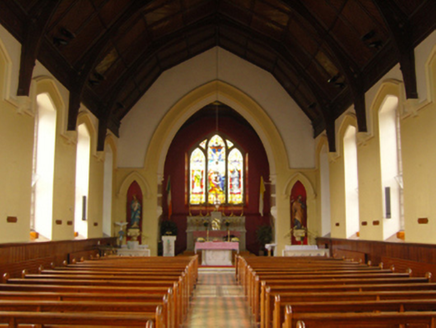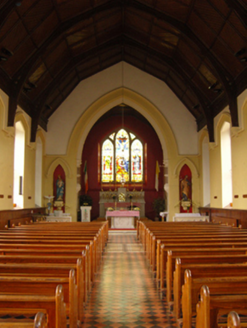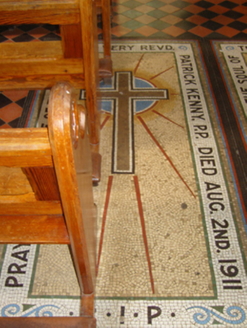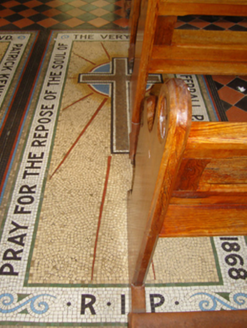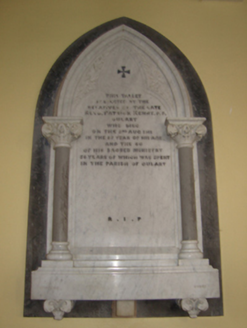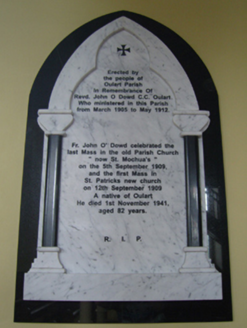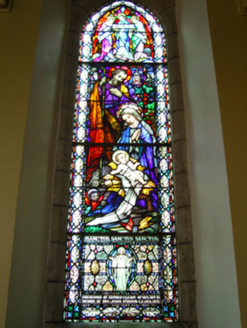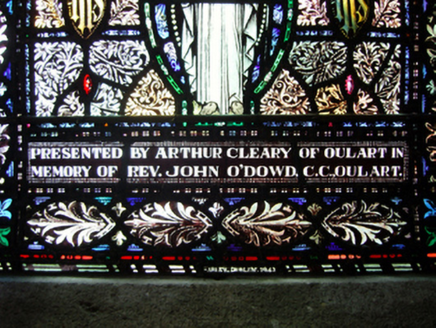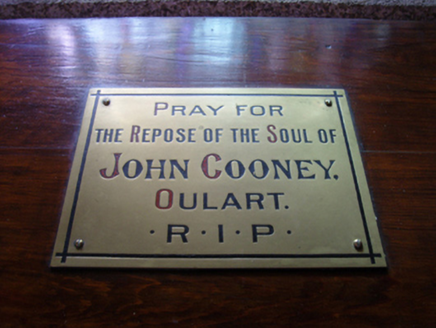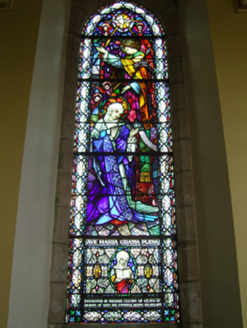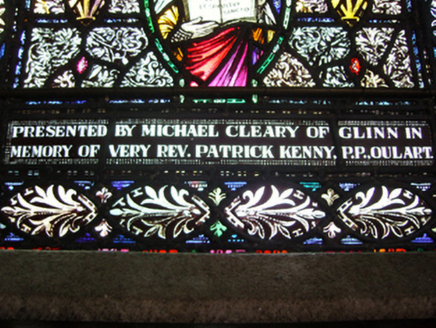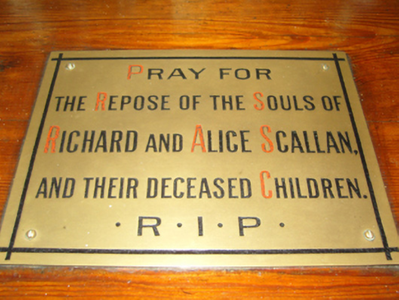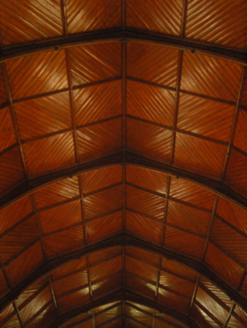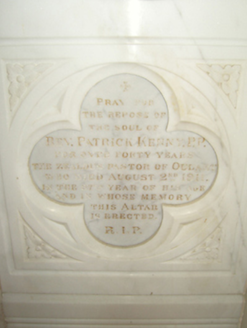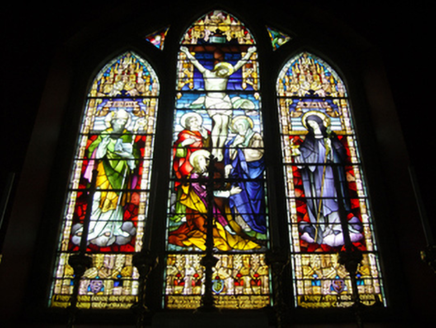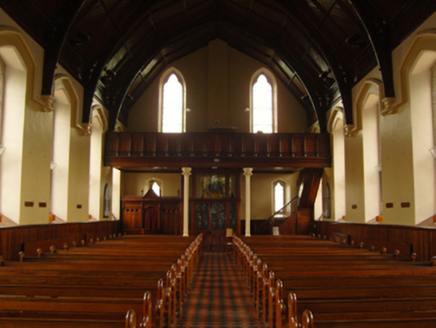Survey Data
Reg No
15702114
Rating
Regional
Categories of Special Interest
Architectural, Artistic, Historical, Social, Technical
Original Use
Church/chapel
In Use As
Church/chapel
Date
1905 - 1910
Coordinates
309417, 140532
Date Recorded
14/08/2007
Date Updated
--/--/--
Description
Detached eight-bay double-height Catholic church, designed 1906; built 1906-9; opened 1909, on a rectangular plan comprising seven-bay double-height nave opening into single-bay double-height chancel (north). Renovated, ----, with sanctuary reordered. Undergoing "restoration", 2009. Pitched slate roofs with trefoil-perforated crested terracotta ridge tiles, cut-granite chamfered coping to gables on "Cavetto"-detailed cut-granite "Bowtell" corbel kneelers with Cross finials to apexes, cut-granite chamfered coping to gable to entrance (south) front with spire-topped cut-granite belfry to apex on an octagonal plan, and cast-iron rainwater goods on cut-granite eaves on cut-granite "Cavetto" consoles retaining cast-iron hoppers and square profile downpipes. Tuck pointed snecked rubble stone walls on cut-granite chamfered cushion course on tuck pointed snecked rubble stone plinth with cut-granite buttresses including cut-granite clasping buttresses to corners (north) having cut-granite "slated" coping; tuck pointed snecked rubble stone surface finish to entrance (south) front on cut-granite chamfered cushion course on tuck pointed snecked rubble stone plinth with "pepper pot" finial-topped granite ashlar clasping buttresses to corners having cut-granite "slated" coping. Lancet window openings with cut-granite block-and-start surrounds having chamfered reveals framing storm glazing over fixed-pane fittings having stained glass margins centred on square glazing bars. Lancet "Trinity Window" to chancel (north) with cut-granite mullions, and cut-granite block-and-start surround having chamfered reveals framing storm glazing over fixed-pane fittings having leaded stained glass panels. Pointed-arch door opening to entrance (south) front approached by flight of four cut-granite steps, cut-granite surround having chamfered rebated reveals with hood moulding over on monolithic label stops framing timber boarded or tongue-and-groove timber panelled double doors. Paired cusped lancet window openings to gable, cut-granite block-and-start surrounds having chamfered reveals with hood mouldings over on monolithic label stops framing storm glazing over fixed-pane fittings having stained glass margins centred on lattice glazing bars. Interior including vestibule (south); square-headed door opening into nave with glazed timber panelled double doors having sidelights on panelled risers below overlight; full-height interior open into roof with Gothic-style timber panelled choir gallery (south) on cast-iron Corinthian colonette pillars, pair of cut-veined white marble Gothic-style wall monuments (ob. 1911; 1941), tessellated "quarry tile" central aisle between Maltese Cross-detailed timber pews with pair of mosaic tiled floor monuments (ob. 1911; 1868), timber boarded or tongue-and-groove timber panelled wainscoting supporting carved timber dado rail, Gothic-style timber stations between frosted glass windows with pair of stained glass memorial windows (1942), exposed pointed-arch braced timber roof construction on beaded "Cavetto" corbels with diagonal timber boarded or tongue-and-groove timber panelled polygonal vaulted ceiling in carved timber frame on carved timber cornice on perforated frieze, and cut-veined white marble stepped dais to sanctuary (north) reordered, ----, with pointed-arch chancel arch framing quatrefoil-detailed cut-veined white marble Gothic-style high altar (1911) below stained glass memorial "Trinity Window" (undated). Set in relandscaped grounds with cruciform-detailed granite ashlar piers to perimeter on chamfered plinths having finial-topped capping supporting cast-iron double gates.
Appraisal
A church erected to a design by George Luke O'Connor (d. 1947) of Great Brunswick Street [Pearse Street], Dublin (Irish Builder 1906, 888), representing an important component of the early twentieth-century built heritage of Oulart with the architectural value of the composition confirmed by such attributes as the compact rectilinear plan form, aligned along a liturgically-incorrect axis; the construction in a green-coloured limestone offset by silver-grey granite dressings not only demonstrating good quality workmanship, but also producing a pleasing palette; the slender profile of the openings underpinning a "medieval" Gothic theme with the chancel defined by an elegant "Trinity Window"; and the polygonal spirelet embellishing the roofline as a picturesque eye-catcher in the landscape. Having been well maintained, the elementary form and massing survive intact together with substantial quantities of the original fabric, both to the exterior and to the vaulted interior reordered (----) in accordance with the liturgical reforms sanctioned by the Second Ecumenical Council of the Vatican (1962-5) where contemporary joinery; restrained wall monuments; mosaic work; jewel-like stained glass signed (1942) by Earley Studios Limited (closed 1975) of Dublin; and the vibrant "Trinity Window" donated by the Right Reverend William Henry Cleary OBE (1859-1929), Bishop of Auckland (fl. 1910-29), all highlight the considerable artistic potential of the composition: meanwhile, an exposed timber roof construction pinpoints the engineering or technical dexterity of a church forming part of a neat self-contained group alongside an adjacent parochial house (see 15702115) and chapel (see 15702116) with the resulting ensemble making a pleasing visual statement in a rural village setting.
